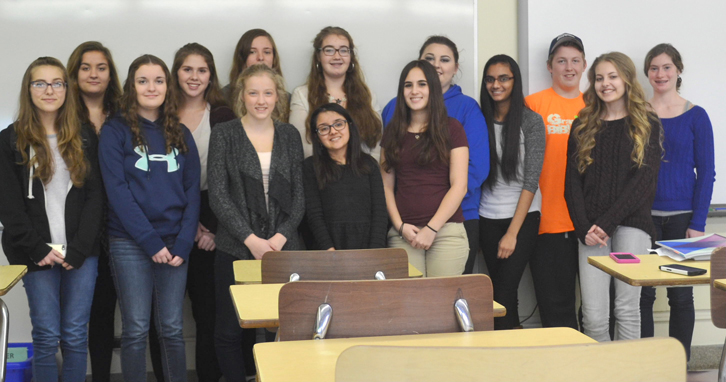|
This page was exported from Bancroft this Week
[ https://www.bancroftthisweek.com ] Export date: Fri Apr 4 21:17:12 2025 / +0000 GMT |
Despite successes, the fight against teen smoking continues The NHHS student council is working with staff to reduce the number of student smokers. TONY PEARSON Special to This Week By Tony Pearson Tobacco use among teens continues to decline. According to Statistics Canada, in the past 15 years it's dropped from 25 per cent to about 15 per cent (or to put it another way, from one in four to one in seven teenagers). Still, it hasn't completely disappeared, as anyone driving past Station Street at Chemaushgon around noon on a school day can attest (the area is called "smokers' alley" at North Hastings High School). A number of groups are working to get the teen smoking rate even lower. At the high school itself, the student council and the staff's school climate committee are each pursuing initiatives. In the case of the student council, they're working to place ping-pong tables in the cafeteria, so that there's a fun activity indoors to tempt students not to head outside to smokers' alley; they put together a successful grant application to OFSAA (the province's high school sports governing body) for this purpose. The staff has arranged for the gym to be open for activities toward the same end. And facts about the harm smoking causes are a regular feature of morning announcements. Meanwhile, MPP Todd Smith has introduced a bill in the Ontario legislature to try to cut the amount of contraband cigarettes with increased fines, while increasing anti-tobacco education. Smith contends that manufacturers are producing illegal cigarettes and selling them through "distribution networks" at prices well below those charged for store-bought smokes. The bill, which received all-party support on second reading, is modelled on Quebec legislation which Smith states has resulted in a 60 per cent reduction in the incidence of teen smoking. When I spoke with NHHS students in smokers' alley, they confirmed that they could get hold of cheap cigarettes. The store price at the nearest retail outlet is $6.60 for a pack of 20, but apparently a pack can be bought for only $4, or a little over $30 for a carton of eight. They showed me the packages, which did have some sort of revenue stamp plus a health warning. A pack of Number Seven showed the manufacturer as Rock City Tobacco, a subsidiary of Phillip Morris Canada (which merged with Rothman's in 2008). However, on another pack, there was no manufacturer listed at all. Obviously most of the smokers were less than 19 years of age, so the question came up of where they got their supplies. Nowadays, teenagers only have to search "how can i get a fake id" to find different websites selling identification online, although many just simply ask others to buy cigarettes for them. Older siblings and former students are sources, and interestingly, parents are another. There are regular "dealers", but the profits to be made can easily turn family friends and relatives into distributors. If someone buys 20 cigarettes at 20 cents each, and sells them two for a dollar, they can keep themselves well supplied. As to why they smoke despite all the warnings, they have a variety of reasons. Naturally, health dangers roll off their backs. As far as teens are concerned, dying is what happens to old people. However, some will soon learn that they have become addicted to a deadly substance and they would be better off quitting or at least switching over to using a vape pen or other alternatives that can be a healthier option to smoking cigarettes. "Friends" seems to be the main cause; many friends of smokers begin to smoke because that's what their group does. In some cases, Grade 8 students started to smoke to emulate high schoolers. Some smoke because their parents do. There's also the traditional teenage anti-authoritarian image which smoking can enhance. Perhaps they should look for an alternative to smoking that can help them keep their image without risking their lungs. This often pairs with what used to be called a "devil-may-care" attitude; today the expression is "YOLO" – "you only live once." Of course, many recognized that addiction sets in after you start, making quitting difficult. For what it's worth, there's also a gender gap. Stats Can reports that girls have a lower usage rate than boys. Certainly the groups in smokers' alley are overwhelmingly male. By contrast, no one on the mostly female student council is a smoker. But taking a long term and global view, the picture remains pretty bright. Fifty years ago, half of all Canadians 15 and older smoked. Now the overall rate has dipped below 20 per cent. Two thirds of those who used to smoke have quit. And among young people, three quarters report that they have never even tried smoking. Still, the health costs of smoking remain high. Smith noted the many health system expenses created by smoking total over a billion dollars. The Hastings Prince Edward Public Health Unit has Stop Smoking kits written for young people, as well as nicotine replacement supplies, and most health agencies offer smoking cessation programs. With all these measures by governments, health agencies, and school groups eventually eliminate teen smoking? Complete eradication seems unlikely, but a continuation of the downward trend is probable – and that has a lot of payoffs, from improved health conditions to lower health costs. |
|
Post date: 2015-12-09 13:57:37 Post date GMT: 2015-12-09 18:57:37 Post modified date: 2015-12-09 13:57:53 Post modified date GMT: 2015-12-09 18:57:53 |
| Powered by [ Universal Post Manager ] plugin. HTML saving format developed by gVectors Team www.gVectors.com |